What is CCM? A guide to Customer Communication Management (CCM)

So you’ve started your business, acquired your first customers, and are ready to scale. Congratulations! While you’re starting to scale, one important tool to add to your tech stack is Customer Communication Management (CCM) software. With CCM software, you can ensure that effective customer communication is not overlooked in favor of other priorities.
Today, customers expect personalized communication as part of their customer experience (CX). Personalization goes beyond addressing customers by name in emails, calls, or chat. It entails understanding each customer’s journey to deliver relevant content and service. That’s where customer communication management (CCM) comes in.
This blog will discuss how your business can provide positive brand experiences through consistent, personalized, omnichannel business communication. You’ll learn why customer communication management is so important, and find out about effective strategies for managing customer interactions. We’ll also explore the CCM tools you can use to reap the benefits of streamlining customer communication.
What is Customer Communication Management? (CCM)
Customer Communication Management (CCM) is a strategic approach businesses employ to design, execute, and manage outbound communications with customers. This methodology seeks to deliver personalized communications across multiple business messaging channels, such as email, SMS notifications, push notifications, web pages, in-app notifications, and printed documents, aiming to enhance customer experiences and engagement. CCM solutions often integrate with existing IT infrastructure to automate the creation and delivery of messages, ensuring consistency and relevancy of content.
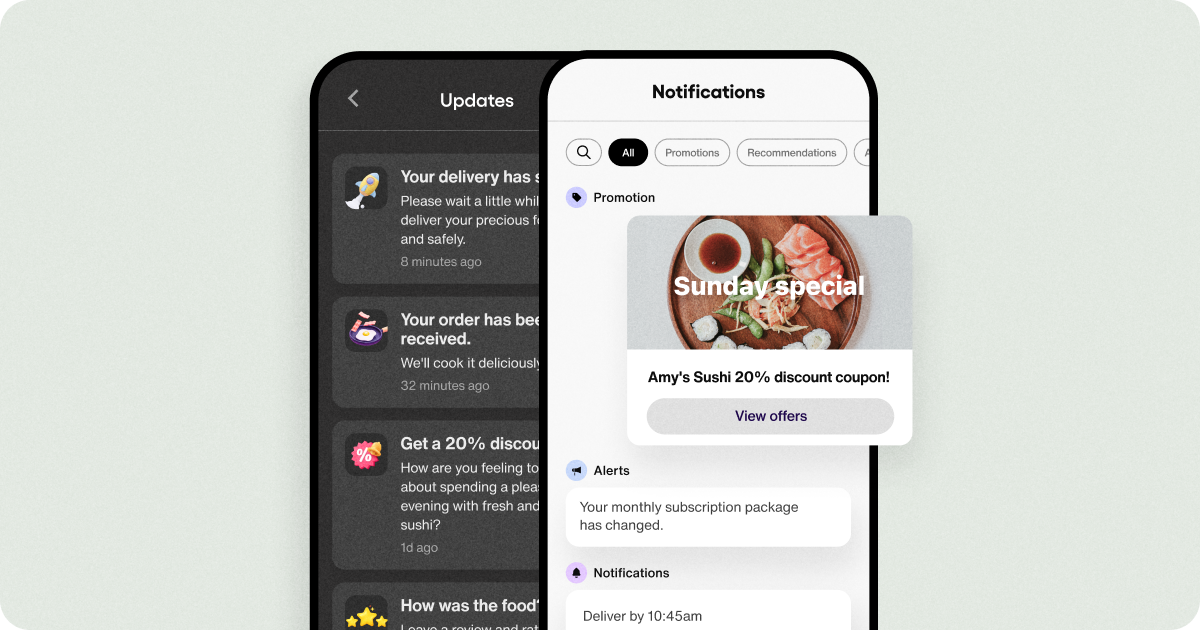
What is CCM software? Why is CCM software important?
CCM software, or Customer Communication Management software, is a tool designed to enhance the way organizations communicate with their customers. It facilitates the creation, customization, and distribution of outbound communications across various channels such as email, SMS, print, and online portals. The software integrates with existing customer databases to utilize personal data for tailored messages, ensuring relevance and personalization. CCM software centralizes customer interaction data from email marketing, websites, CRMs, and social media channels. CCM software also gives teams across your organization a unified view of the customer, ensuring excellent interactions at every touchpoint. With data analytics and customer insights, CCM enables organizations to tailor communications to individual customer preferences and behaviors, thereby optimizing customer satisfaction and loyalty.
Optimizing and enhancing the customer experience can have a direct impact on revenue: Customer stats show that companies with a great customer experience win 5.7x more revenue than their competitors, while customers are willing to spend 17% more for a good experience.
What is CCM in business?
Customer Communication Management (CCM) in business involves more than just using tools; it's about creating a strategy that integrates these tools into a comprehensive plan to improve customer interactions. A comprehensive CCM strategy involves analyzing customer data and behaviors to craft personalized messaging, delivered across preferred channels, thereby fostering a more meaningful connection with each customer. This strategy is not just about technology but also involves setting up the right processes and fostering a customer-focused culture within the organization. By doing so, businesses can improve their relationships with customers, leading to increased loyalty and satisfaction. This approach to CCM helps businesses communicate more effectively and build stronger connections with their audience.
5 effective types of customer communication management (CCM)
There are multiple ways to manage customer communication.
Automated Document Factory (ADF): This creates and delivers high-volume correspondence such as annual reports, invoices, or monthly statements. It collects and converts raw data into official documents and distributes these assets across all communication channels.
Multi-channel distribution: This type covers tools that distribute communications across a variety of platforms. Whether through email, SMS, direct mail, third-party chat apps, in-app notifications, push notifications, or social media, these tools ensure that messages reach customers on their preferred platforms, optimizing engagement and response rates.
Business Process Automation (BPA) automates business processes using artificial intelligence (AI) and machine learning (ML), for instance, using support chats to answer FAQs. Organizations reduce costs, improve efficiency, and increase customer satisfaction.
Customer communications processes: These develop personalized communication plans based on customer segments, factoring in buying patterns, preferred communication channels, level of customer engagement, and more. Interactive communications are used to engage customers and enhance customer interactions. They are commonly used in customer service portals, mobile apps, or web applications, where immediate feedback or decision input is required from the customer.
Omnichannel business messaging: This synchronizes business messaging among multiple channels, allowing businesses to track interactions across customer touchpoints, such as in-app notifications, push notifications, and SMS.
An effective CCM platform performs two or more of these processes. For it to yield the best results, your CCM platform must be user-friendly and integrate seamlessly with your existing tech stack, including your CRM solutions.
Top 6 benefits of implementing CCM software
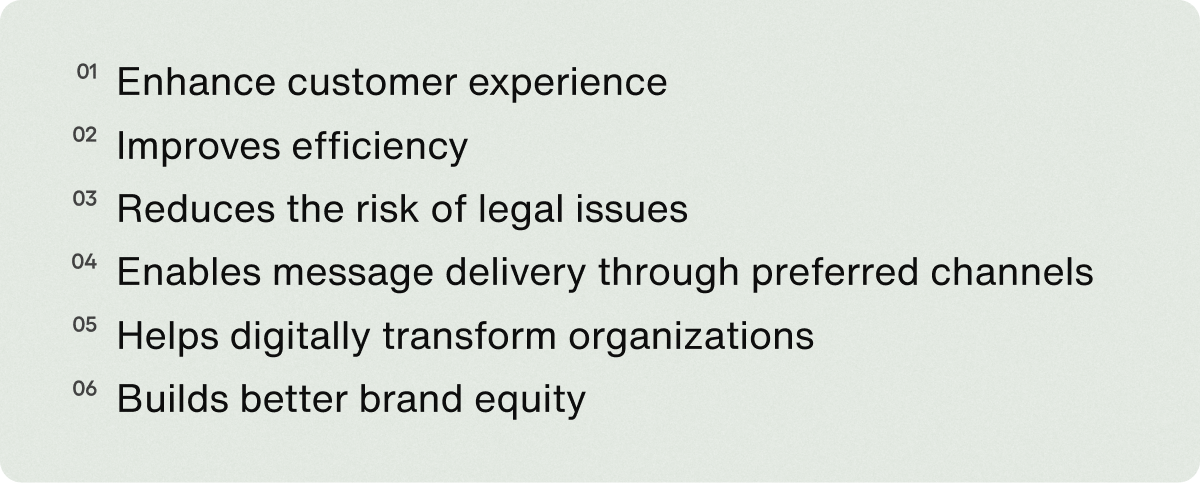
Businesses are no longer competing on price; they’re competing on customer service. Consequently, customer service isn’t limited to customer support teams. Positive interactions with your accounting, marketing, and sales teams contribute to the brand's perception. Here are the top six benefits of implementing CCM across your business.
1. Enhances customer experience
Customer experience is the overall impression customers have of your business as they go through the buyer journey. From your social media ads to your monthly newsletters, every communication touchpoint impacts the user experience of your brand.
Customer communications management software enhances CX by creating consistent messaging regardless of where the communication originates. Let’s say your marketing team offered trial customers an additional free month. One week later, they receive an automated payment notification to update their credit card information to continue using the service.
Understandably, customers will be confused and lose trust in your company. CCM minimizes these scenarios by ensuring customers don’t receive conflicting messages from different departments. Consistency builds trust, driving customer loyalty and sales.
2. Improves efficiency
CCM creates enhanced experiences for customers and employees. Departments in your organization use different tech and collect different types of customer data. For instance, finance teams collect billing information. Meanwhile, marketing teams collect behavioral data to execute personalized SaaS marketing strategies. These data sets are usually stored in separate locations, creating data silos.
CCM eliminates these barriers to information sharing and organizes data to create a holistic view of the customer. With access to customers' previous transactions, video or voice call histories, and business messaging preferences, customer-facing teams can provide quicker, better service.
3. Reduces the risk of legal issues
Industries like healthcare and finance have strict regulations around how businesses collect and use customer information. For instance, healthcare marketers can’t use protected health information in marketing campaigns. CCM enforces regulatory compliance by enabling the legal team to review content. It also limits user access controls, preventing unauthorized access to confidential data.
Another way CCM reduces legal risk is by eliminating data silos. Storing customer information in multiple locations increases opportunities for cyberattacks and data breaches. Centralized CCM enables IT teams to locate data breaches quickly and mitigate the fallout.
4. Improves customer satisfaction due to message delivery through preferred channels
CCM allows companies to gather customer data to create a comprehensive customer profile. Customer personas outline buyers’ values, pain points, and goals. They also include information about potential customers’ preferred marketing channels.
Not all customers are on social media. And even those who are might prefer calling your customer service reps over combing through your website’s knowledge base. So, don’t scrap your call centers just because AI agents are cheaper. Honoring channel preferences for business messaging shows customers you care about them, improving customer satisfaction.
5. Helps digitally transform organizations for digital maturity
The digital revolution has introduced numerous tools for improving business processes. However, the banking and government industries still use legacy systems with obsolete IT infrastructure. The problem with this setup is that growth can be limited due to restricted integration functionalities, security vulnerabilities, and operational inefficiencies.
Leading customer communication management solutions, however, integrate with existing core systems, enabling established businesses to use legacy software in modern digital environments.
6. Builds better brand equity
Brand equity refers to the commercial value a business gets from positive brand perceptions. Remember what we said about competing on CX, not price? Here is an expression of that. Customers will pay more for products with a good brand reputation even though their competitors may offer the same for less. This price difference directly impacts sales margin, creating more profits with each sale.
CCM contributes to brand equity by improving your brand’s image through consistent brand messaging.
CCM vs. CRM: What’s the difference between customer communication management and customer relationship management?
Customer Communications Management (CCM) and Customer Relationship Management (CRM) are similar concepts. Both manage customer interactions, but their objectives and goals differ.
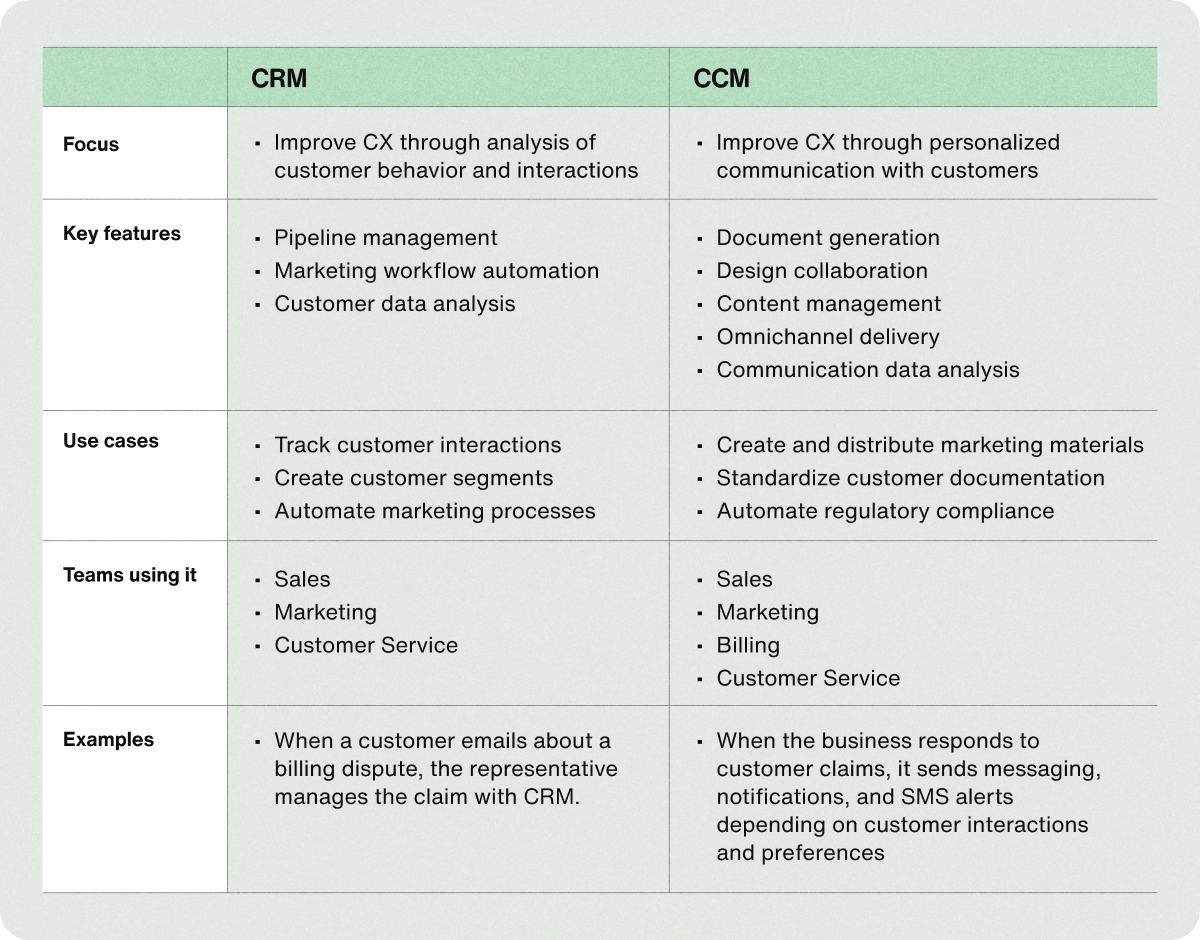
Combining CCM and CRM creates a comprehensive approach to delivering personalized experiences. CRMs collect and analyze customer behavior, while CCMs create brand-consistent messaging that delights customers.
5 best practices and tips for enhancing customer communication management
We have seen that CCM is critical for your business; what are some best practices to follow to boost your CCM efforts?
1. Create a well-thought-out customer communication plan
A good customer communication plan outlines who businesses communicate with, what they say, and how they deliver the message. It ensures employees share the correct information with customers, reducing errors in miscommunication. It also allows you to act promptly and consistently and avoid a customer service crisis. So, whether it’s an email, website, or social media comment, the message is the same.
The steps for creating a communication plan are as follows:
Define your objectives: What outcomes do you want your communication efforts to achieve? Is it increased brand visibility, customer satisfaction, or sales? Setting goals allows you to tailor messages to meet them. Emails driving brand awareness for a feature launch look and sound different from those engaging inactive customers.
Identify target audiences: Your customers have different interests and interaction histories. So, premium users shouldn’t receive the same marketing calls as customers on the freemium plan. Identifying and segmenting audiences ensures you send the right messages to the right customers.
Determine the appropriate communication channels: Knowing and using customers’ preferred channels increases responsive rates. Consider using a mix of channels to capitalize on each platform’s advantages. For instance, SMS and social media are great for promoting flash sales but not your quarterly earnings report.
Map communication activities on a content calendar: A clear roadmap of your communication efforts ensures you engage customers regularly. You can also map the customer journey and develop targeted interactions for trial leads, sales-ready leads, or churned customers.
Here’s an example of a multi-target communication plan.

It identifies target audiences, outlines distribution channels, describes communication content, and assigns a responsible team member.
2. Efficiently manage customer data using a CRM system
Customer data on spreadsheets is manageable if you have fewer than 100 contacts with static information like names, phone numbers, websites, and email addresses. It becomes complicated as you scale and track dynamic data like transaction history, complaints, or web page visits.
So, you need a CRM system to manage customer data from various sources and automatically update customer interactions. You avoid instances where customer service teams send wrong information because of untimely manual updates.
3. Customize communications by leveraging available data
Personalization is the name of the game! It’s why you collect useful customer data such as communication preferences, demographics, or interests. After all, customers don’t like receiving generic text messages or emails. Moreover, it’s not enough to insert customers’ names on marketing materials and call it a day; personalization means crafting messages based on users’ place in the buyer journey.
Here’s an example of an abandoned cart email.
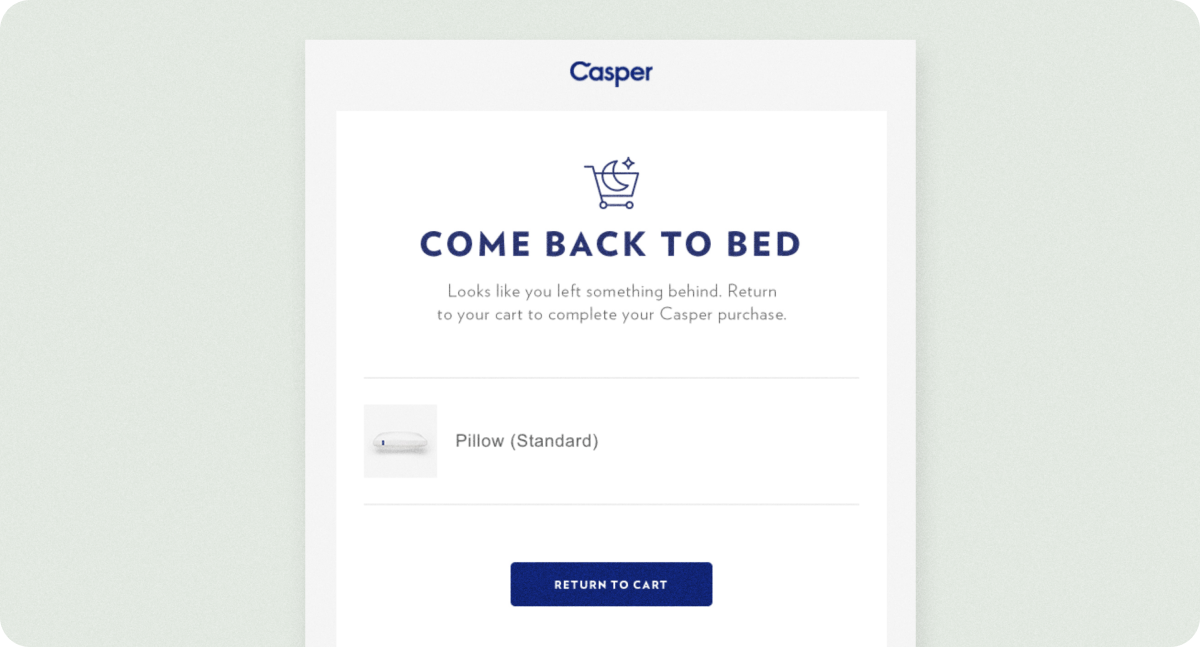
Tracking the customer’s website activity data allowed Casper to create this email encouraging the customer to complete the transaction.
Other ways to leverage data for personalization include transaction history to recommend products, milestones to offer discounts, and customer feedback to announce feature updates.
4. Prioritize outstanding experiences for high-value customers
The Pareto Principle states that 80% of results come from 20% of efforts; for our purposes, this translates to 80% of revenue coming from 20% of customers. Keeping high-value customers happy comes down to providing excellent service. These include offering exclusive content, early access to new products, engaging superusers for product development, and providing proactive support.
Proactive support can be self-service portals through chatbots or feature onboarding.
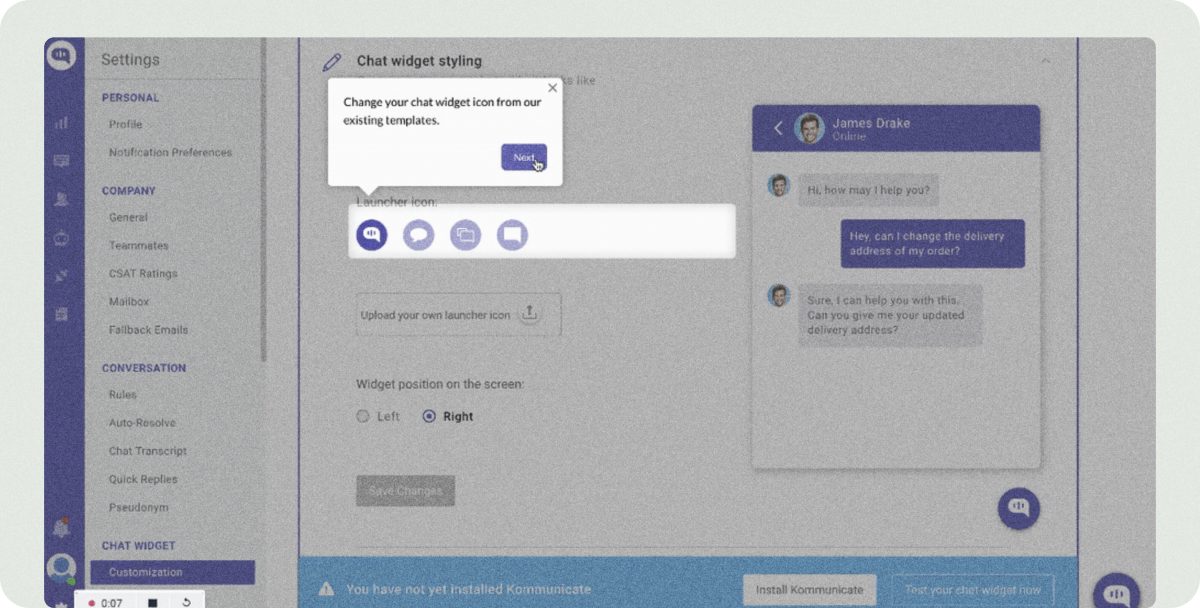
Instead of a comprehensive product tour, Kommunicate interactively guides users as they use each feature. Here, the app helps the user customize the chat widget step-by-step, so users don’t have to look for how-to guides when they want to use certain features.
5. Consistently follow up with your customers
The customer journey doesn’t end when the customer buys your product. For instance, SaaS brands must continually engage happy customers to maintain or increase customer retention rates.
Follow-up messages aren’t a formality. Sending a post-purchase survey or checking in after resolving customer issues makes the customer feel valued and builds rapport and trust. These messages also help spot and address potential problems.
CCM software: Top 5 CCM tools you need to know
The management of customer communication requires the right tools. Here are five CCM solutions to help you create personalized communication.
1. Sendbird Business Messaging
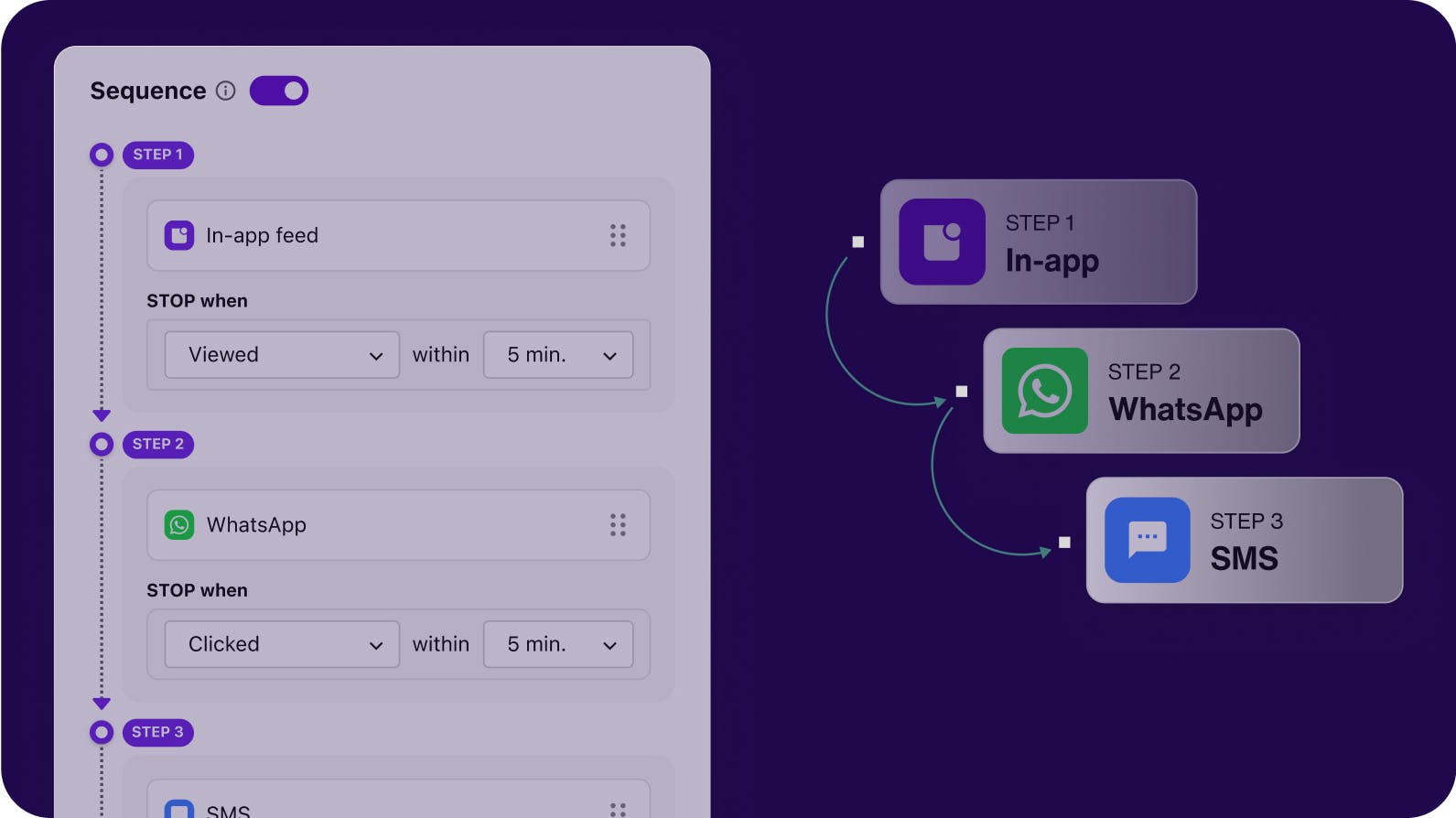
Sendbird Business Messaging is an omnichannel business messaging platform that empowers Product, Operations, Support, and Engineering teams to streamline and sequence omnichannel messages. As part of your tech stack, Sendbird Business Messaging facilitates CCM in the following ways:
Use a no-code notification builder: Design custom, media-rich notifications in an intuitive no-code notification builder. For added flexibility, use developer-friendly APIs and UIKits.
Implement channel sequencing: Select an optimal mobile channel mix and reach customers on their preferred communication channel. Ensure your notification is not unseen or ignored. Select from in-app notifications, push notifications, SMS, WhatsApp, and KakaoTalk.
Orchestrate and schedule timings: Customize delivery rules to minimize costs and enhance the customer experience.
Evaluate insightful analytics: With general analytics, get a high-level overview of notifications sent. Monitor open rates and A/B test messages with message campaign analytics. Analyze single-user interactions to gain precise engagement insights and iterate on your messages.
Streamline communication across teams: Sequence, streamline, and analyze communications to send product updates, policy change alerts, support messages, or marketing campaigns.
White label notifications: Customize the notifications interface with corporate logos and colors, showcasing brand identity.
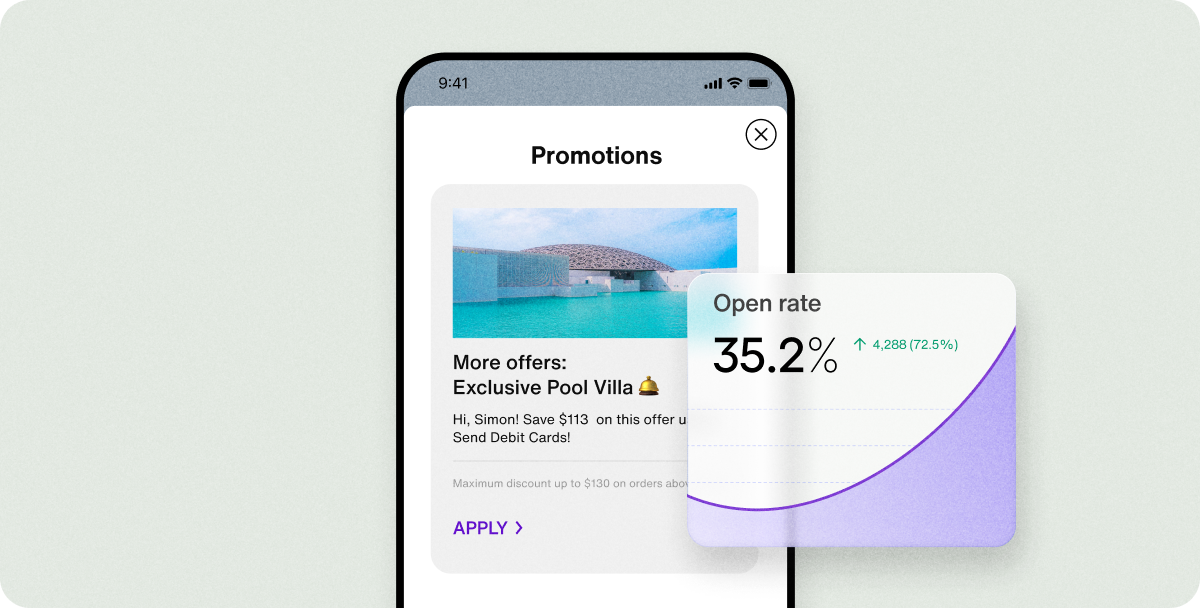

How to build the perfect mix of mobile customer communication channels
2. Quadient Inspire
Quadient is a leader in customer experience management. The software enables the health, finance, and public sectors to create personalized communication throughout the customer lifecycle, with message delivery through digital and print channels.
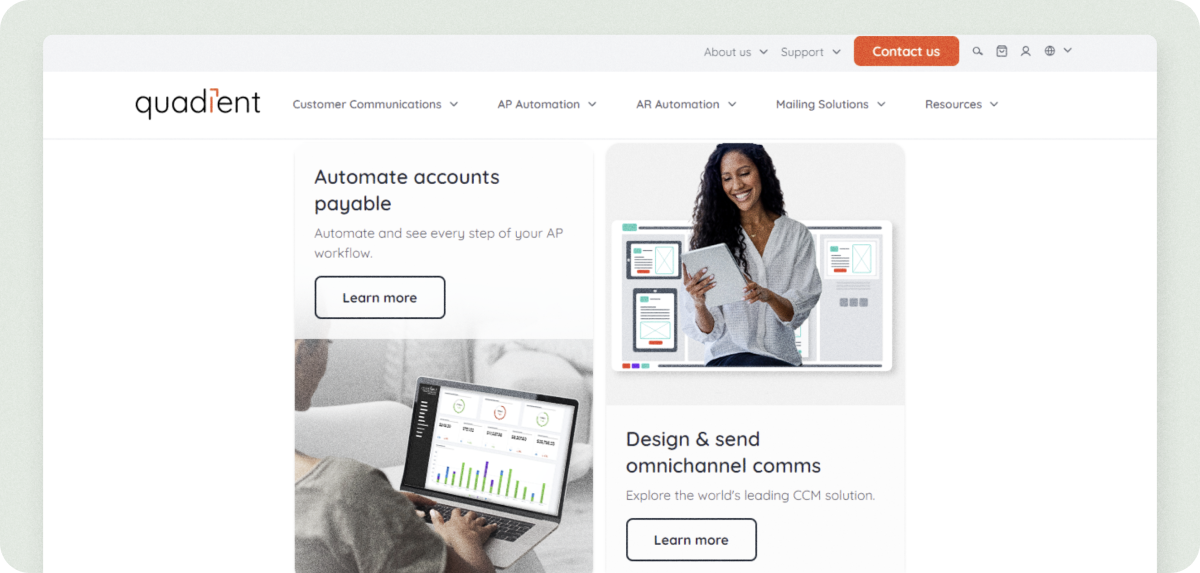
In addition to centralizing data and personalizing communication, the Inspire suite of products includes customer journey mapping, which visualizes and connects the journey to deliver omnichannel experiences.
Pricing is available upon contacting the company.
3. Adobe Experience Manager (AEM) Forms
Adobe Experience Manager Forms is an Adobe Experience product that allows businesses to send automated, personalized letters and statements.
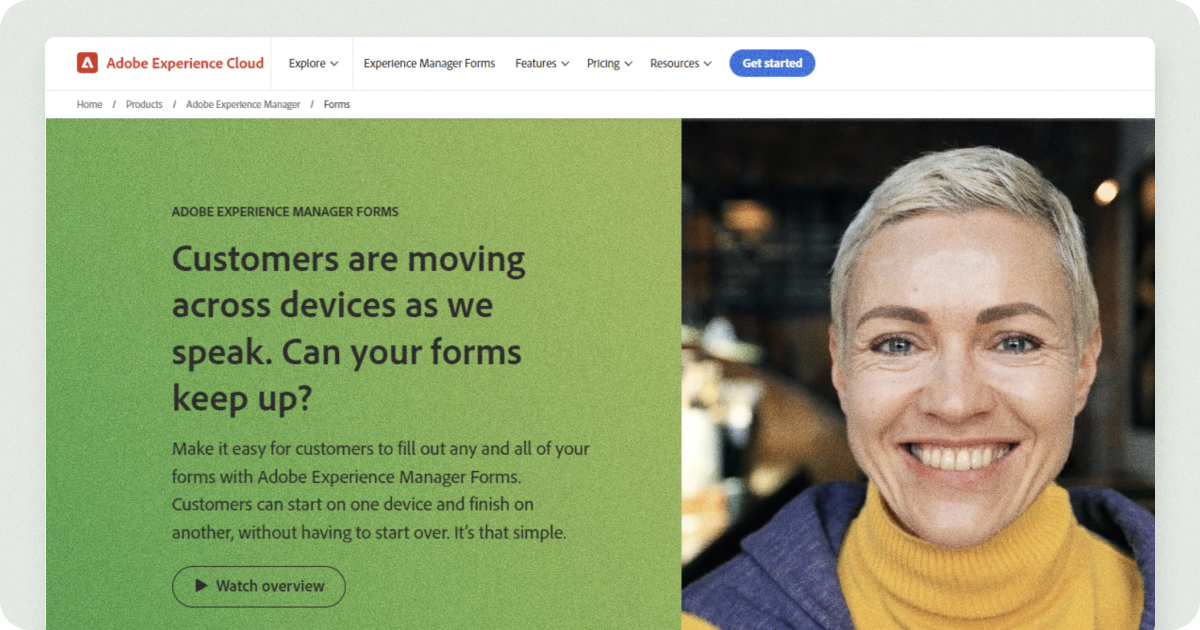
It integrates with most CRM and ERP systems, enabling targeted content. The streamlined authoring feature drags and drops data elements directly into templates, optimizing content creation.
Pricing depends on transaction volume, usage requirements, and product options.
4. EngageOne Communicate
EngageOne is part of Precisely’s comprehensive security program. It designs and delivers communication through interactive videos, chatbot and virtual assistants, personalized emails, real-time SMS, and dynamic PDFs.
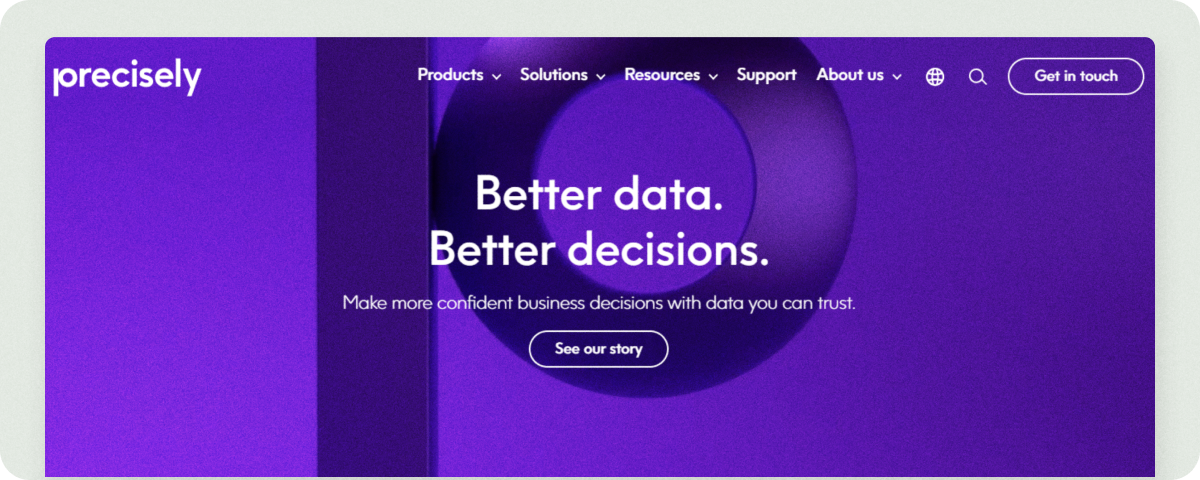
Pricing is not publicly available. There is a 30-day free trial.
5. Hyland Content Composer
Hyland is a content management company for the financial, healthcare, education, and manufacturing industries.
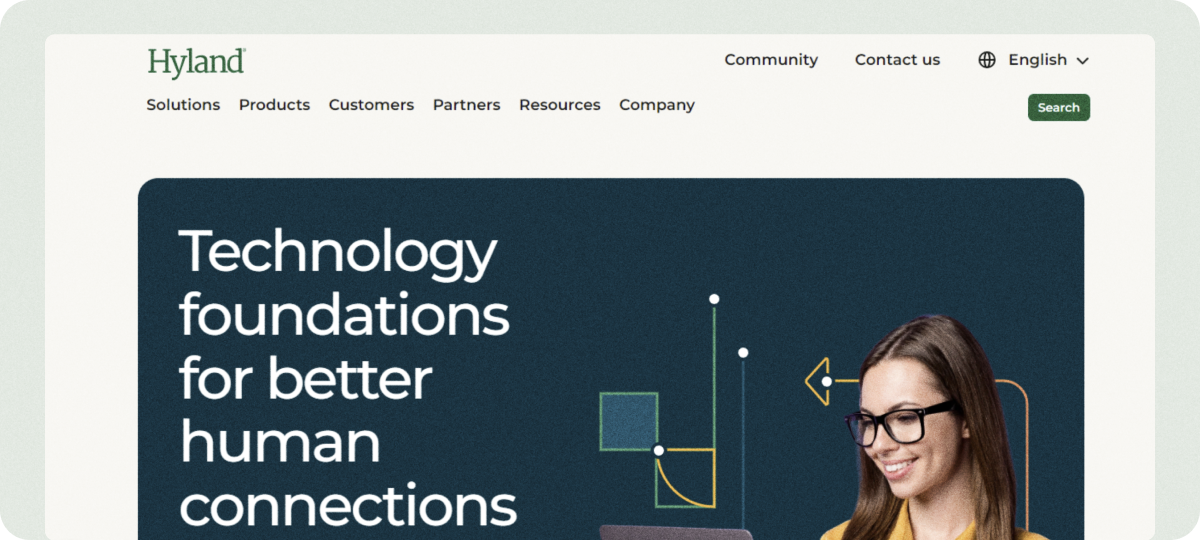
It creates automated, rule-based communication with interactive controls to personalize content. It also integrates with over 500 applications and delivers content in web and mobile-compatible formats.
Pricing is not available publicly.
6. Zendesk Sunshine Conversations
Zendesk Sunshine Conversation is a messaging platform powered by a unified API, giving you access to data from every channel. With it, you can create tailored experiences that help prospective customers complete their journey through various messaging apps, such as Facebook Messenger or WhatsApp.
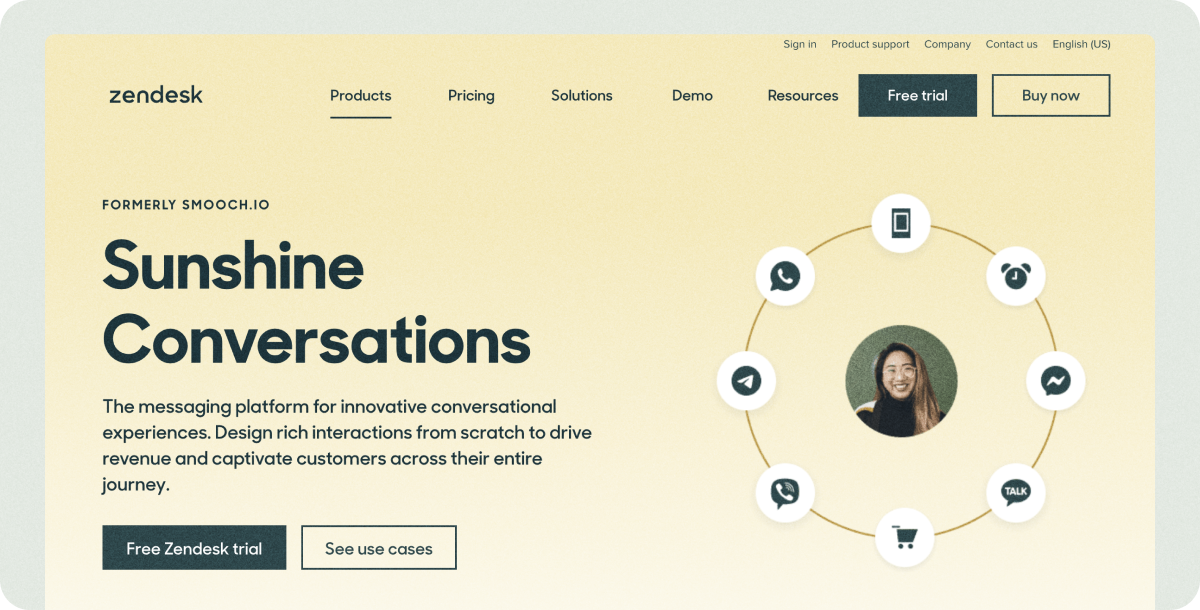
You can get Sunshine Conversation as a standalone product or part of the Zendesk professional or enterprise suites.
Overhaul customer communication management today
Customer communications management simplifies and standardizes communication, ensuring consistent messaging at every customer touchpoint. Miscommunication and notification fatigue decrease with document templates and aligned teams.
CCM solutions are becoming more common as companies transition from competing on product price to competing on brand value. If you’re ready to take your customer communication management strategy to the next level with push notifications, in-app notifications, WhatsApp, SMS, and KakaoTalk, sign up for free or contact us today to truly elevate the customer experience.









